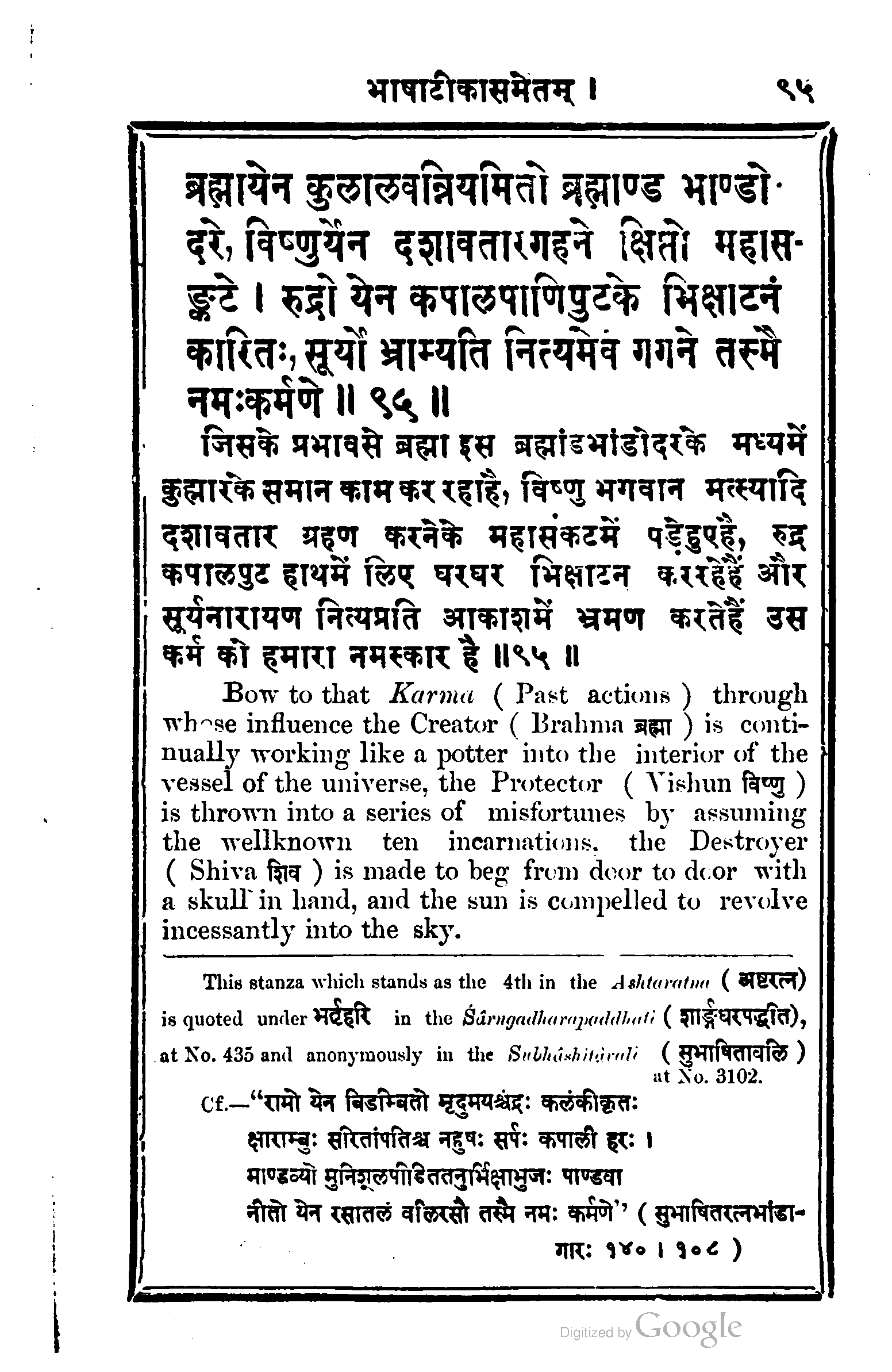Tawney
Telang
verse

Text (not proofread)
ब्रह्मा येन कुलालवन्नियमितो ब्रह्माण्डमाण्डोदरे
विष्णुर्येन दशावतारगहने क्षिप्तो महासंकटे ।
रुद्रो येन कपालपाणिपुटके भिक्षाटनं कारितः
सूर्यो भ्राम्यति नित्यमेव गगने तस्मै नमः कर्मणे ॥ ९ ५ ॥
footnote

Text (not proofread)
XCV . ( b ) क्षिप्तो महा ; न्यस्तो महा ● Be.n. क्षिप्तः सदा D. P. ( c ) ° टनम् ;
● यणम् Bo.n. कारितः ; सेवते N.
endnote


Text (not proofread)
St. XCV . DESHID is a common expression comp . Vîra
charita p . 17 or Sahityadarpana p . 97. The allusion is to the
story of Brahms coming out of the primordial egg the two
halves of which then became Heaven and Earth . See Manu
I. , St. 11 , 12 13 and Matsya Purâna II . , 28 et seq . re
fers to the work of Brahma within the egg in the formation of
things . Râmarshi says ब्रह्माण्डभाण्डानि far विधातुं farà नियम्यते but what is then
the meaning of उदर ? गहन is explained by वन and संकट in one
copy of the commentary . By Râmarshi it is explained thus *
विपिन कवा . महासंकटे is explained by अतिसंवाधरूपे by Ramarshi . There
are it seems to me two ways of interpreting this expression ( 1 )
गहन being taken as meaning forest , and महासंकट 88 8 Bahu
vrihi meaning full of great difficulties ; ( 2 ) गहन being taken as
an adjective , महासंकटे as meaning “ in the great difficulty . " For the
latter interpretation , which I prefer , may be compared भूरिंदोषगहनो
दर्यामयः in Viracharita p . 59 or विवेकप्रसादुपचित महामोहगहनो । विकार :
कोपन्तर्जंडपति च तापं च कुरुते in Malati Madhava p . 55. For भिक्षाटनं कारितः
see Siddh . Kaum . II . , 278. कपालपाणिपुटके should be taken as a Ma
dhyamapadalopi - compound equivalent to कपालसहितपाणिपुटके . The
story of Rudra's begging with a skull in his hand may be seen
summarised from the Skanda Purâna in the note to Chandakau
s'ika p . 45 ( Calc . Ed . ) . Râmarshi interprets it differently . He
says कपालं तुम्बीफळशकलं तदेव पाणिपुटकं हस्तपुटकम् . But this is obvi
ously not satisfactory . श्रीसूर्ये इत्युपलक्षणम् | चन्द्रादयो ग्रहा अपि भ्रमन्ति }
says Râmarshi . The sentiment of this Stanza again shocks the
orthodoxy of the commentators . One copy of the commentary
has the following ब्रह्मविष्णुसूर्यादीनां प्राचीनकर्म वर्तते इति वक्तुं नैवोचितम् ।
दृष्टान्तस्तावदेकदेशी वर्तते । तैयैस्कार्यमकृतं तस्कुर्वन्ति । दृष्टान्तस्तु लोकव्यवहारार्थ
लिखितः कर्मणि महत्वस्थापनार्थम् || But the idea is not so uncommon &
one as this indicates . Thus in the Yoga - Vâsishtha quoted in the
commentary on the Ramayapap . 12 ( Bomb . Ed . ) we read तेनापि शापितो
विष्णुः सर्वज्ञत्वं तवास्ति यत् ॥ किंचित्कालं हि तत्स्यवस्था लमज्ञानी भविष्यास . And this
is given as the occasion of Vishnu's incarnations . Another account
of them may be seen at Matsya Purâņa XLVII . , St. 103-4 where
Bhrigu says to Vishpu : यस्मात्ते जानतो धर्ममवध्या स्त्री निषूदिता ॥ तस्मान्वं सप्त -
कृत्वह मानुषेधूपयन्स्यसि ॥ ततस्तेनाभिशापेन नष्टे धर्मे पुनः पुनः ॥ लोकस्य हितार्थाय
जायते मानुषेविह ॥ This Stanza occurs in the Kāvyasangraha p .
Sardilavikridita .
Kosambi
verse

Text (not proofread)
ब्रह्मा येन कुलालवन् नियमितो ब्रह्माण्डभाण्डोदरे
विष्णुर्येन दशावतारगहने क्षिप्तो महासंकटे ।
रुद्रो येन कपालपाणिपुट के भिक्षाटनं कारितः
सूर्यो भ्राम्यति नित्यमेव गगने तस्मै नमः कर्मणे ॥ २८५ ॥
footnote

Text (not proofread)
285 { N } Om . in X. " ) Ws - गहन- ( ior - गहने ) . 11le He W2 . 3 सदा ; It
तथा ( for महा ) . ( ) X 1 शंभुर ( for रुद्रो ) . 1 पाणिपिटके ; पाणिरनिशं ; Get
" पात्रपुटके . भिक्षाटने ; J1.2M + भिक्षाश ( J2 ( स ) नं ; 12 भिक्षाटणं . J1.3 Y2.4–6_'T_G4
M 4 , 5 सेवते ; J2 Y : सेवित :; Gity . कुर्वते ; Get कार्यतः ( for कारित :) . d ) Eat भ्रामति ;
Ms भ्रम्यति यहशेन ( for नित्यमेव ) . Xo . 7 गहने ( for गगने ) .
BIS . 4197 ( 1994 ) Bhartr ed . Bohl . and lith ed . I. 2. 93. Haeb . 38. Galan
97. lith . ed . II . 95 , III . 1. Astarataua 4 in Hach . p . 8. Vikramacarita 261 ; Sp .
435 ( Bh . ) ; SRE . p . 93. 98 ( Bh . ) ; SBIH . 3102 ; SRK . p . 76. 1 ( Śp . ) ;
Garulamahapurana 113 15 ; 85. 46. 7 ; SL f 39 & ; SN . 799 ; SSD . 4. f . 5 & ; SSV .
298 ; JSV . 262. 2 .

